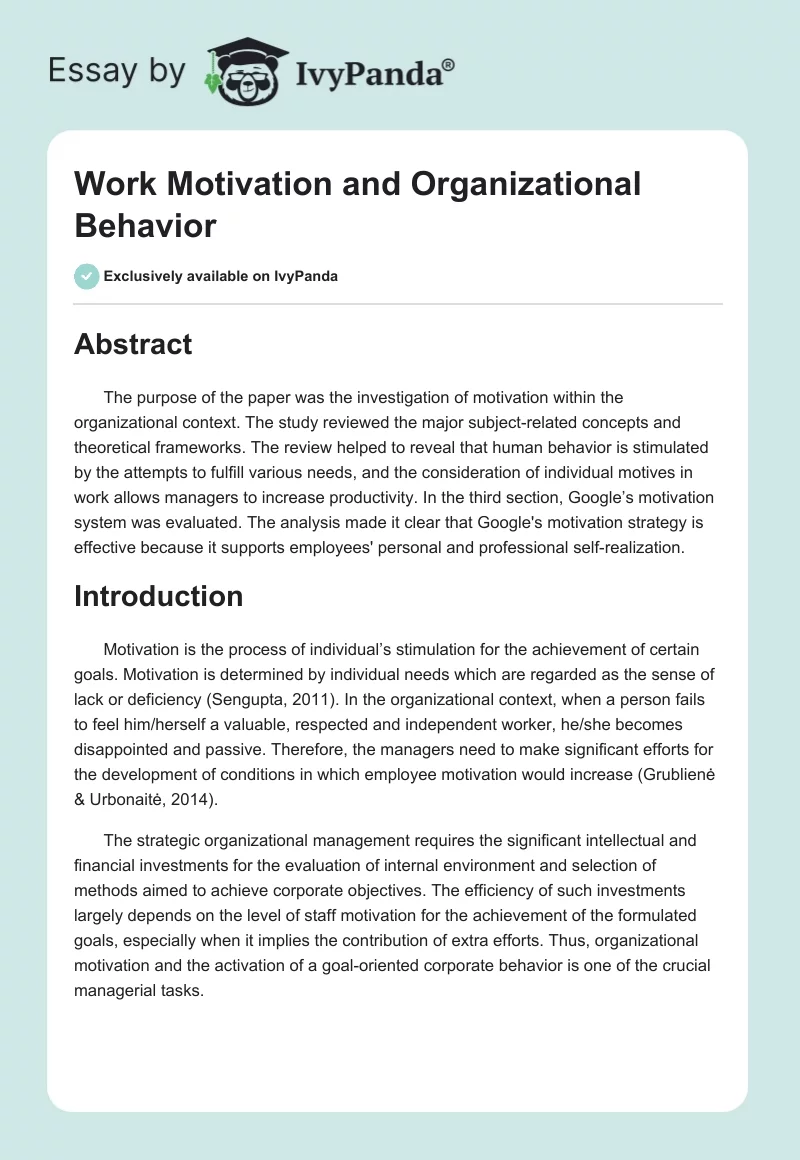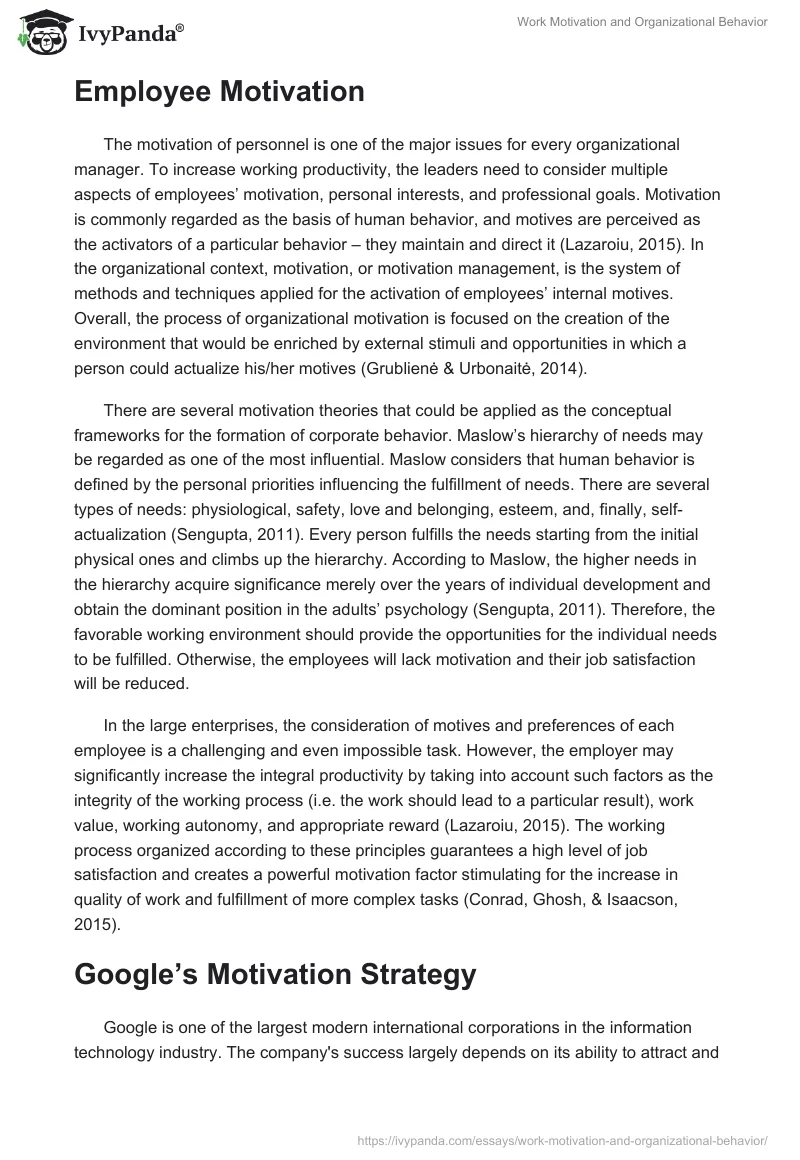Abstract
The purpose of the paper was the investigation of motivation within the organizational context. The study reviewed the major subject-related concepts and theoretical frameworks. The review helped to reveal that human behavior is stimulated by the attempts to fulfill various needs, and the consideration of individual motives in work allows managers to increase productivity. In the third section, Google’s motivation system was evaluated. The analysis made it clear that Google’s motivation strategy is effective because it supports employees’ personal and professional self-realization.
Introduction
Motivation is the process of individual’s stimulation for the achievement of certain goals. Motivation is determined by individual needs which are regarded as the sense of lack or deficiency (Sengupta, 2011). In the organizational context, when a person fails to feel him/herself a valuable, respected and independent worker, he/she becomes disappointed and passive. Therefore, the managers need to make significant efforts for the development of conditions in which employee motivation would increase (Grublienė & Urbonaitė, 2014).
The strategic organizational management requires the significant intellectual and financial investments for the evaluation of internal environment and selection of methods aimed to achieve corporate objectives. The efficiency of such investments largely depends on the level of staff motivation for the achievement of the formulated goals, especially when it implies the contribution of extra efforts. Thus, organizational motivation and the activation of a goal-oriented corporate behavior is one of the crucial managerial tasks.
Employee Motivation
The motivation of personnel is one of the major issues for every organizational manager. To increase working productivity, the leaders need to consider multiple aspects of employees’ motivation, personal interests, and professional goals. Motivation is commonly regarded as the basis of human behavior, and motives are perceived as the activators of a particular behavior – they maintain and direct it (Lazaroiu, 2015). In the organizational context, motivation, or motivation management, is the system of methods and techniques applied for the activation of employees’ internal motives. Overall, the process of organizational motivation is focused on the creation of the environment that would be enriched by external stimuli and opportunities in which a person could actualize his/her motives (Grublienė & Urbonaitė, 2014).
There are several motivation theories that could be applied as the conceptual frameworks for the formation of corporate behavior. Maslow’s hierarchy of needs may be regarded as one of the most influential. Maslow considers that human behavior is defined by the personal priorities influencing the fulfillment of needs. There are several types of needs: physiological, safety, love and belonging, esteem, and, finally, self-actualization (Sengupta, 2011). Every person fulfills the needs starting from the initial physical ones and climbs up the hierarchy. According to Maslow, the higher needs in the hierarchy acquire significance merely over the years of individual development and obtain the dominant position in the adults’ psychology (Sengupta, 2011). Therefore, the favorable working environment should provide the opportunities for the individual needs to be fulfilled. Otherwise, the employees will lack motivation and their job satisfaction will be reduced.
In the large enterprises, the consideration of motives and preferences of each employee is a challenging and even impossible task. However, the employer may significantly increase the integral productivity by taking into account such factors as the integrity of the working process (i.e. the work should lead to a particular result), work value, working autonomy, and appropriate reward (Lazaroiu, 2015). The working process organized according to these principles guarantees a high level of job satisfaction and creates a powerful motivation factor stimulating for the increase in quality of work and fulfillment of more complex tasks (Conrad, Ghosh, & Isaacson, 2015).
Google’s Motivation Strategy
Google is one of the largest modern international corporations in the information technology industry. The company’s success largely depends on its ability to attract and retain the brightest minds and the most skillful individuals for the engagement in research and technology development. Nowadays, Google implements an original and highly successful staff motivation strategy that helps to increase productivity in an efficient way and make the company a global leader in employee motivation.
High salary is an important component of Google’s motivation strategy success. According to the recent data, Google pays the largest salaries to its developers in the whole Silicon Valley (Vise, 2006). It helps the company to retain highly qualified personnel from switching to the competitors, such as Apple, Microsoft, and Facebook.
Secondly, Google creates the unique comfort at the workplace – its offices are projected by the best global designers, and the interior design in each of its international units is developed according to both general tendencies and national preferences.
Google is a result-oriented company. The employees are allowed to work in any convenient and preferable way, and the positive outcome is the only thing that is required. Personnel fulfills the daily tasks in the unconventional conditions: it is possible to work in the leisure rooms, the meetings may be held in the hammocks on the rooftop, and one can easily ride on a skateboard around the office. Google’s motivation implies the absence of reporting and other stress factors as such. But the employee must demonstrate the most important thing – the result. Moreover, motivation is sustained by the operational transparency. The results of individual work are seen and evaluated by the whole team. This approach increases employee responsibility and strengthens working team cohesiveness by emphasizing the social aspect in the organizational environment.
Google’s strategy is people-oriented. Among all mentioned factors, the company provides employees with multiple financial and material bonuses such as medical and retirement insurance. The corporate facilities include gyms, beauty salons, relaxation centers, canteens, etc. Moreover, the company provides the family support. For example, an employee gets two-month vacation at the birth of a child, and in the case of an employee’s death, his/her family would get half his/her salary.
Advantages and Disadvantages
The main potential disadvantage of Google’s motivation system is the high level of financial costs. Thus, the given strategy is likely inapplicable for the majority of less financially advanced enterprises. However, other aspects of Google’s employee motivation system may be regarded as effective, and by following Google’s principles, other firms may significantly improve job satisfaction indicators and achieve productivity increase.
First of all, the skills and competence of an employee in Google are recognized and respected. It means that the company addresses the needs for self-esteem development and self-realization. The companies where the employees’ abilities are not paid enough attention will likely experience challenges in the attempts to increase productivity (Conrad, Ghosh, & Isaacson, 2015). It is important to cultivate the feeling of appreciation in the employees and underline the unique value of each individual. Such approach motivates the staff members for self-development and enhancement of professional skills.
Google’s corporate culture is based on multiple social, ethical, and scientific values which support the organizational work importance and value. The employees understand the significance of their work and it stimulates them for the achievement of better and sooner high-quality results (Grublienė & Urbonaitė, 2014). When an individual fails to comprehend the purpose of his activities, the quality of his/her work suffers. Therefore, the formulation of any task requires the disclosure of the ultimate goals and the potential consequences of its fulfillment because it supports the employees’ determination and high level of commitment.
Google’s employees are provided with the opportunities for the autonomous decision-making, and it increases the level of responsibility. The organization provides workers with all necessary tools, materials, and equipment and gives the options to choose. This approach helps to maintain the employees’ working independence and self-discipline. Moreover, frequently received feedbacks and the opportunity to discuss the issues help to maintain the high quality of results and correct the working process in time (Lazaroiu, 2015). The feedbacks and the constant involvement in the colleagues’ working processes allow the leaders to reduce the chances of negative outcomes or defects and increase the overall operational efficiency.
Conclusion
The motivation is a phenomenon associated with the personal characteristics, and the success of the organizational motivation system depends on its ability to meet and fulfill the physical and psychological needs of each employee. It is possible to say that the strategy developed by Google is highly effective because it is grounded in the solid value base. It provides the employees with the necessary financial, intellectual, and material resources and helps them to reveal their potential. Google’s strategy emphasizes the autonomy of individual working process the high quality of which is controlled by the result-oriented policies and high level of employees’ commitment. Google’s motivation system requires large financial investments and it thus cannot be applied universally. However, the organizations may achieve significant results in employee motivation by implementing the individual-oriented strategies and integration of values into the corporate culture.
References
Conrad, D., Ghosh, A., & Isaacson, M. (2015). Employee motivation factors. International Journal of Public Leadership, 11(2), 92-106. doi:10.1108/ijpl-01-2015-0005
Grublienė, V., & Urbonaitė, A. (2014). Organizational culture strengthening and employee motivation improvement. Management Theory and Studies for Rural Business and Infrastructure Development, 36(3), 507-515. doi:10.15544/mts.2014.047
Lazaroiu, G. (2015). Work motivation and organizational behavior. Contemporary Readings in Law and Social Justice, 7(2), 66-75.
Sengupta, S. S. (2011). Growth in human motivation: Beyond Maslow. Indian Journal of Industrial Relations, 47(1), 102-116.
Vise, D. A. (2006). Google. Foreign Policy, (154), 20-24.


